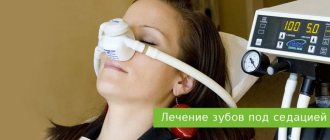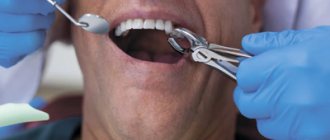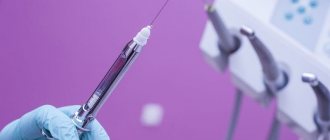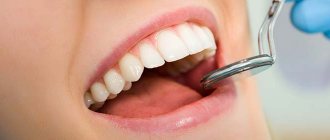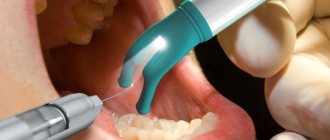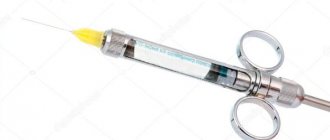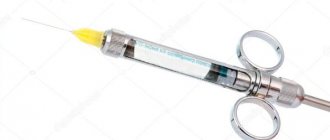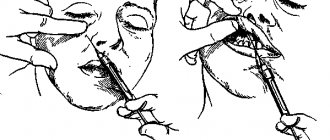- Operating principles
- Anesthesia methods
- Indications and contraindications
- Types of anesthesia
- pain relief in pregnant women
- Anesthesia for children
- Recommendations
- Complications
- Drugs used
- Price
Nowadays, it is possible to receive medical care not only fast and high-quality, but also painless. Almost any action of the doctor that can bring discomfort or unpleasant sensations to the patient is accompanied by dental anesthesia, or in other words, “freezing”. He stops experiencing pain and fear and relaxes, allowing the dentist to calmly do his job.
Operating principles
Anesthesia is carried out immediately before the start of treatment. The anesthetic comes in both liquid and gel form. The doctor injects into the soft tissues that are located near the diseased tooth. After some time, the tongue, gums and cheeks become numb and “freeze”. At this moment, the anesthetic acts as a blocker of nerve impulses that send a pain signal to the brain. The patient calmly endures dental procedures without experiencing stress.
The duration and effectiveness of dental anesthesia depends on the quality of the materials used and the location of the injection. The closer to the problem area the injection was administered, the more intense its effect. Each organism is individual, therefore the drug will be excreted at different rates.
Different types of drugs function in their own ways. For example, gel-like ones applied to the gums or surface of the cheek last only a couple of minutes. If they are installed in the upper part of the jaw, the effect will last for 2-3 hours. To treat the lower group of teeth, a deeper injection is required, so the result lasts up to 4 hours. After the solution is absorbed, the numbness disappears and sensitivity returns to the patient.
Preparation for the procedure
For intraligamentary anesthesia, Lidocaine, Ultracaine and Trimecaine are usually taken. All of these drugs are standard and are used in almost all methods of local anesthesia.
The procedure performed before each type of treatment is an allergy test (allergy test). If the patient has doubts or does not know his body’s reaction to a certain type of medication, this manipulation is mandatory.
The test is also performed if there is a history of:
- bronchial asthma;
- allergic rhinitis;
- hay fever;
- atopic dermatitis.
If the patient has had Kvitke's edema, anaphylactic shock, or has never had his teeth treated with anesthesia, at least once, he should warn the doctor about this. In such situations, it is also necessary to do an allergy test.
To test the drug that he plans to administer, the dentist dilutes it with saline solution. Then 0.1 ml of the resulting solution is injected intradermally into the wrist. The test result is assessed according to the following indicators:
- The reaction developed instantly - the result is positive, and means that the use of this medicine should be discontinued.
- The reaction appeared within 20 minutes . – immediate effect. Just as in the first case, the use of the drug is contraindicated.
- There is no reaction (no changes on the skin) – negative result. The medicine is allowed for use.
Anesthesia methods
Depending on the goals and nature of the problem, the doctor chooses the method of pain relief. In medicine there are two main methods:
Anesthesia
It is most often used in surgery, and in dentistry much less often, in case of urgent need. It affects the entire body of the patient, inducing a state of sleep. At this time, all muscles relax and consciousness turns off. You can administer painkillers intravenously or inhale vapors through a mask. Deep anesthesia is used during complex operations when a person does not have enough strength to cope with pain or it is necessary to completely eliminate body movement. During sleep, the doctor monitors the patient's condition to avoid emergency situations.
Recovery from anesthesia is the body’s return to normal functioning after a long “freeze.” For all people, this process proceeds differently, some experience signs of nausea or a feeling of lethargy, while others wake up well-slept and rested.
General anesthesia in dentistry during pregnancy is applicable only in emergency cases when there is no other alternative.
Local anesthesia
Unlike anesthesia, it occurs locally, affecting only certain areas of the body. Can be used for children and pregnant women, without fear of unwanted consequences. In dental practice, this method is most often used, so we will talk about it in more detail.
Key Aspects
When carrying out the procedure, the dentist must take into account the following conditions:
- The number of anesthetic injections directly depends on the number of roots in the tooth, i.e. one injection is enough for a single-root unit, and two for two roots.
- Anesthesia of one element requires 0.12-0.19 ml of anesthetic solution.
- If the injector has a dispenser with a volume of 0.06 ml, then this amount of medication is administered slowly over 7 seconds. For a single-rooted tooth, the input is repeated up to three times with an interval of 7 seconds.
- After the injection, do not immediately pull out the needle. You need to wait about 10 seconds so that the drug does not come out.
During the procedure, the doctor makes sure that the anesthetic does not leave. If this happens, he must reduce the pressure on the piston, or the needle insertion depth was not sufficient. This also happens when the needle is pressed strongly against the root or alveolus when it is blocked.
To fix the problem, you should change the position of the injector. If there is no result, you need to check how well the medicine passes through the needle.
The main sign of correct manipulation is the appearance of pallor of the gum tissue around the anesthetized tooth.
Indications and contraindications for the use of local anesthesia
Any dental intervention that causes pain must be accompanied by “freezing” of the required area of the oral cavity. There is a list of diseases for the treatment of which it is necessary to administer anesthetic drugs:
- Complex caries;
- Removal of a tooth or its roots;
- Periodontitis;
- Inflammatory processes in the dental system;
- During prosthetics.
Before drawing up a treatment plan and choosing medications, the doctor must interview the patient and find out from him the presence of contraindications in order to exclude the possibility of complications.
- Allergy to drugs used;
- Heart diseases;
- Diabetes;
- Problems with the endocrine system.
Advantages of the technique
Among the positive aspects that characterize intraligamentary anesthesia are:
- Convenient protocol implementation that does not require special skills;
- Effective action of the composition, guaranteeing the required result in 99% of cases;
- Safety and painlessness of the procedure for patients;
- Promptly achieving the desired effect.
The technology provides correct pain relief, allowing for almost any type of dental intervention.
Types of anesthesia
There are several methods in medicine; they differ in duration, effectiveness and location.
Conductor.
The most common type of local anesthesia in dentistry. Using a special needle, the drug is injected near the nerve trunk, blocking pain impulses that go to the brain. The injection is given in doses not exceeding a volume of 5 ml. To ensure a guaranteed result, the injection is placed at an angle of 90 degrees.
“Freezing” applies only to a certain group of teeth, in the place where the treatment will take place. After about 15 minutes, the medicine begins to work and the doctor can begin work.
The injection site can be additionally lubricated with lidocaine. If during the procedure the patient continues to feel discomfort, another dose may be administered.
Infiltration
It differs from the conductor only in the angle of the needle and the place of application. The drug is injected directly into the root apex area. This type is most effective for teeth and upper jaw. With infiltration anesthesia, you can “freeze” both a small area and a large surface of the oral cavity along with soft tissues.
Applique
This method is performed without a syringe. The dentist applies the necessary product directly to the diseased tooth and the soft tissues surrounding it using a cotton swab or fingers. Some doctors spray anesthetics using a special spray.
It is mainly used during simple and quick operations, since its effect is short-term and does not protect against severe pain. The result is stored for a maximum of 20 minutes. It is often used as the first stage before the injection “freezing” method.
Intraosseous
The dentist resorts to this technique much less often when other types of anesthesia have proven ineffective. An analgesic that is injected directly into the hard tissues between the teeth. The difficulty lies in the technique; to get to the bone, the doctor cuts the gum and drills a hole in it with a bur. This is the most effective method for quickly and permanently freezing the required area.
Intraligamentary
Its peculiarity is the high speed of injection, so numbness occurs almost immediately, but lasts only 20-30 minutes. The advantage of intraligamentary anesthesia in dentistry is that it acts directly on the tooth without touching the cheeks, lips and tongue. That is why the recovery process is much easier.
Types of anesthetics and injectors
For intraligamentous anesthesia, special carpule syringes are used. A wide range of models are available in dentistry, but they all meet standard criteria, which include:
- Maintaining high blood pressure during injection;
- The presence in the structure of a special liquid drainage system;
- Equipped with a rotary or angled attachment that changes the inclination of the needle.
In addition, a prerequisite is the use of materials that are resistant to sterilization procedures, ease and ease of use.
Among the popular models of carpule syringes are:
- STERINJECT and PERI-PRESS are cross-shaped products that include a latch for simultaneous fixation with four fingers. Application of muscle force allows 0.2 ml of anesthetic to be injected with each lever press;
- CITOJECT – models similar in shape to a standard fountain pen. The presence of a piston element and a comb ensures the introduction of 0.3 ml of the composition during injection;
- PAROJECT – hollow small-sized cylindrical syringes, made of metal, and delivering up to 0.6 ml of solution per press.
In addition, other models are also popular among dentists, including the Russian development IS-01-1-Mid, which is distinguished by its rotating head design.
Anesthetics used for pain relief belong to the category of capsule formulations with local action. A standard ampoule contains 1.8 ml of a solution containing an amide anesthetic and a vasoconstrictor.
Features of pain relief in pregnant women
One of the most common misconceptions is that pregnant women are contraindicated for dental treatment. You should not trust unreliable sources; dentistry and pregnancy are completely compatible concepts. Expectant mothers should undergo a professional examination during planning and at 8, 18 and 28 weeks of pregnancy. Untreated infections in the oral cavity contribute to the development of other dangerous diseases.
The question immediately arises: can the use of dental anesthesia harm the health of the unborn child? Modern technologies allow the use of drugs with lower concentrations of adrenaline. Accepted painkillers are ultracaine, primacaine or mepivacaine*. They do not penetrate the placenta, therefore, do not harm the body of a pregnant woman.
*A verified and accurate list of acceptable medications can be obtained from your doctor.
Prices for tooth extraction at Apex-D dentistry
| Name | rub. |
| Opening an abscess | 500 |
| Abscess drainage | 350 |
| Removal of a single root tooth | 2000 |
| Removal of a double-rooted tooth | 2500 |
| Removal of a three-root tooth | 3000 |
| Removal of the third molar “wisdom tooth” of the upper jaw | 3000 |
| Removal of the third molar “wisdom tooth” of the lower jaw | 3500 |
| Root separation | 350 |
| Hemisection | 1500 |
| Osteotomy | 1500 |
| Socket curettage | 300 |
| Tamponade with iodoform turunda | 300 |
| Alvaugille | 300 |
| Neocones | 300 |
| Stitching | 750 |
| Periostotomy | 500 |
| Hemostasis | 200 |
| Cystectomy | 3000 |
| Cystectomy with resection of the apex of one root, frontal group | 4500 |
| Cystectomy with resection of the apex of one root, chewing group | 5500 |
| Cystectomy, resection of each subsequent apex | 1500 |
| Cystotomy | 1500 |
| Cyst removal | 1000 |
| Closed curettage | 1000 |
| Open curettage of one tooth area | 1500 |
Modern dental practice makes it possible in most cases to prevent tooth extraction. The doctor’s rule is to prescribe tooth extraction surgery only as a last resort, when all available treatment methods have been tried and it is no longer possible to save the tooth, or in the event that the problematic tooth is the cause of the development of more serious complications.
Anesthesia for children
Painless pediatric dentistry is a hot topic today. All parents know what a trip to the dentist means for a child. If this brings few pleasant emotions to an adult, then what can we say about children. The first scheduled visit is always scheduled for the age of 6-7 years - this is the time when baby teeth are replaced with permanent ones.
The psyche of children is not yet fully formed; one wrong word or action can provoke the development of unpleasant memories. Therefore, it is important to instill confidence in the child, to mentally prepare him for the procedure: explain why he is going there and what the doctor will do. The use of anesthetic agents in pediatric dentistry is an integral part of comfortable treatment.
The most suitable injection methods for babies are infiltration, conduction and application. The place where the drug is administered is “frozen” in advance and only then does the doctor give an injection. The child’s body is not yet fully formed, so in pediatric anesthesia, special medications are used that make it possible to carry out the procedure safely.
Possible complications
Despite the simplicity of the procedure, it must be performed by an experienced, highly qualified doctor. If a mistake is made, there is a possibility of adverse consequences and complications.
Such conditions include:
- Bacteremia . During the injection, in 70% of patients, microorganisms from the gingival groove are pushed into the bed of the vessel. This risk can be reduced by high-quality antiseptic treatment of the furrows.
- Injury to the ligamentous apparatus . It manifests itself as temporary pain when percussion or pressure is applied to the treated unit during the first 24-36 hours after treatment. This happens if the anesthetic was administered very quickly.
- Local necrosis of the mucosa at the site where it was pierced with a needle . It develops as a result of incorrect anesthesia, i.e., when the solution is quickly administered, the needle is incorrectly positioned, or the volume of the drug is incorrectly calculated (its excess).
The dentist’s knowledge of the anatomical structure and features of the maxillofacial apparatus, high-quality antiseptic treatment, and modern equipment will help eliminate these complications.
Recommendations
For the successful use of anesthetics, there are two conditions: 1) the patient must abstain from drinking alcohol at least 24 hours before treatment; 2) feel good.
Often, after the effect of painkillers wears off, the patient experiences pain, swelling, tingling at the injection site, and difficulty opening the mouth (trismus). Within 2-4 days, all residual effects should disappear.
After treatment, sensitivity returns gradually, so take the food carefully so as not to accidentally bite yourself. It is also recommended to quit smoking during this time.
Reviews
Opinions about intraligamentous anesthesia for the most part are only positive, both from dentists and from their patients.
Having a minimum number of contraindications, this technique is effective, safe and most convenient, and also facilitates easier treatment.
If you have experience in dental treatment under intraligamentary anesthesia, and you would like to express your opinion about its effectiveness and feasibility, share it in the comments to this article.
If you find an error, please select a piece of text and press Ctrl+Enter.
Tags intraligamentary anesthesia
Did you like the article? stay tuned
No comments yet
